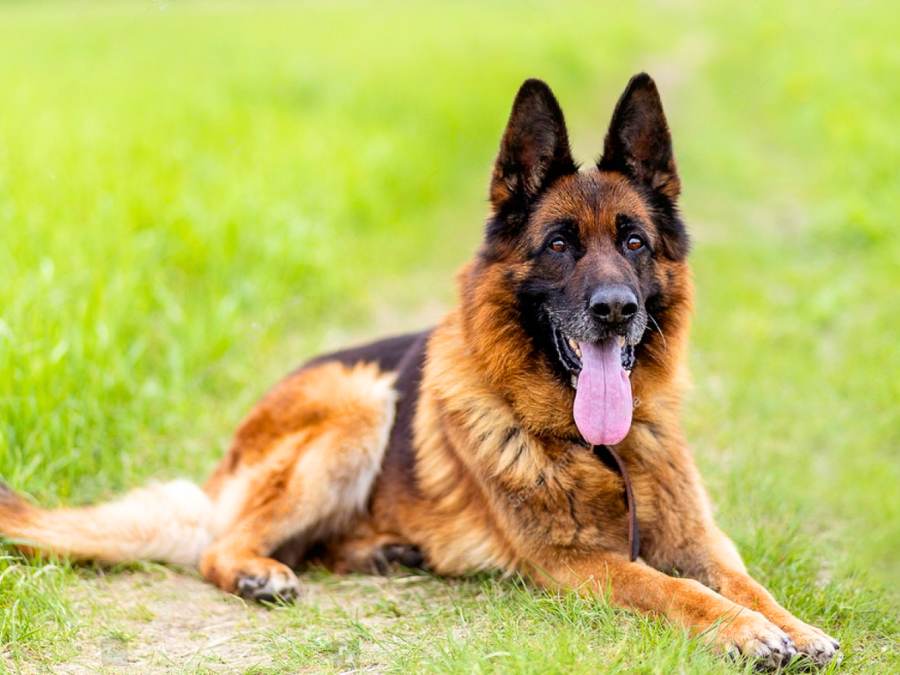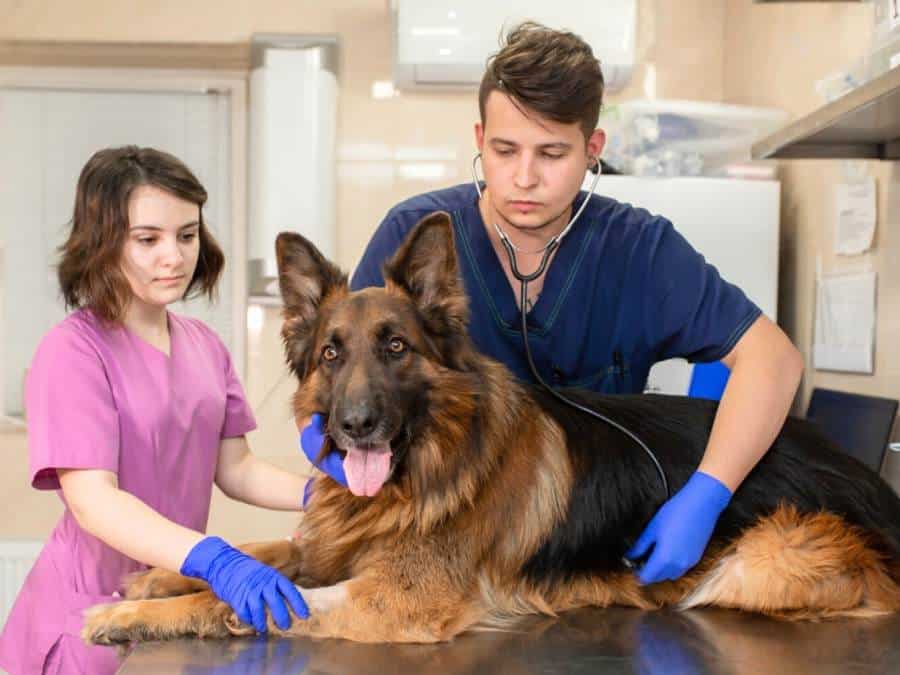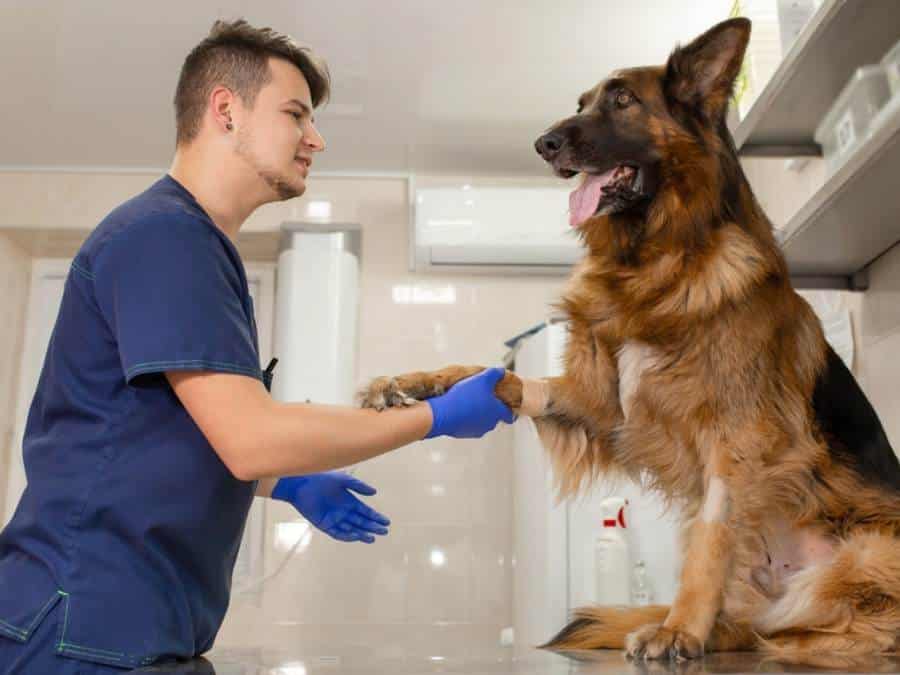While often it’s not a cause for alarm, understanding the nuances of German Shepherd eye discharge is crucial for any owner. This condition can range from a clear, watery secretion to a more concerning green or yellow discharge, indicating a variety of underlying health issues.
Recognizing the different types of eye discharge and knowing when to seek veterinary care can play a significant role in maintaining your dog’s eye health.
In this comprehensive guide, we’ll explore everything you need to know about German Shepherd eye discharge, from its common causes and treatments to effective home care tips and preventative measures.
5 Types of German Shepherd Eye Discharge
Generally, eye discharge is the body’s way of clearing out dirt and debris. However, the type of discharge can give us clues about the health of our canine friends.
Pay attention to the color and consistency to determine whether it requires veterinary attention.
1. Clear and Watery Discharge
Clear, watery discharge from a German Shepherd’s eyes can range from benign to serious, depending on the underlying cause.
This type of discharge can result from irritants, foreign materials in the eye, allergies, or anatomical abnormalities such as prominent eyes or rolled-in eyelids.
Blocked tear ducts, corneal wounds, or glaucoma are also potential causes of excessive tearing.
You should monitor your GSD for persistent teariness, especially if the eyes become red and painful or if other types of discharge develop, signaling the need for a veterinary appointment.
2. Thick White or Gray Mucus
A thick white or gray mucus discharge is often indicative of dry eye (keratoconjunctivitis sicca or KCS), a condition that should be taken seriously.
In KCS, the dog’s immune system attacks and destroys the tear glands, leading to a compensatory increase in mucus production.
This results in red, painful eyes that may develop abnormal corneal pigmentation or ulcers. Without treatment, KCS can cause extreme discomfort and even lead to blindness.
The presence of white-gray mucus around the eyes warrants immediate veterinary attention.
3. Yellow or Greenish Discharge
Yellow or green discharge, particularly when accompanied by redness or discomfort, is a classic sign of an eye infection.
Eye infections in German Shepherds can arise independently or as a complication of other conditions such as dry eye or corneal wounds.
In some instances, this type of discharge may indicate a systemic illness rather than a localized eye infection.
Regardless, yellow or green discharge is a cue for immediate veterinary evaluation and treatment to address the infection and underlying causes.
4. Red or Brown Tears
Light-colored GSDs often exhibit reddish-brown discoloration near the corners of their eyes, a result of porphyrin pigment exposure to air.
While it may look concerning, this staining is purely cosmetic. Regular wiping with a warm water-dampened cloth or a specialized eye-cleaning solution can minimize tear stains.
Keeping the area trimmed and utilizing antibiotic-free nutritional supplements can also reduce the appearance of these stains.
However, if the staining intensifies, changes appearance, or is accompanied by pain and redness in the eyes, a veterinary consultation is necessary.
5. Excessive Tearing and Redness
Any occurrence of excessive tearing accompanied by redness warrants a check-in with your veterinarian.
These symptoms can signal a variety of eye conditions that require professional diagnosis and treatment to prevent further discomfort or potential complications.
By staying vigilant and understanding these common types of German Shepherd eye discharge, you can better care for their GSD’s eye health and act promptly when issues arise.
RELATED: German Shepherd Red Eyes

Common Causes of Eye Discharge in German Shepherds
Several factors can lead to eye discharge in German Shepherds, ranging from simple irritants to more serious health conditions:
- Conjunctivitis: Inflammation of the eye’s outer layer, causing redness, swelling, and often, thick discharge.
- Allergies: Pollen, dust, and other environmental allergens can cause eyes to water and discharge clear fluid.
- Blockages: Tear duct blockages can lead to excessive tearing and discharge.
- Injuries: Scratches or trauma to the eye can result in discharge as the eye attempts to heal.
- Foreign Bodies: Grass seeds, dirt, or other foreign objects in the eye can cause irritation and discharge.
- Diseases: Certain diseases, like dry eye (Keratoconjunctivitis sicca) or glaucoma, can also lead to eye discharge.
Recognizing the underlying cause is crucial for effective treatment and relief for your dog.
RELATED: Common German Shepherd Eye Problems
Managing Eye Boogers in German Shepherds
Eye boogers, or the crusty, gooey buildup that can occur in the corners of a German Shepherd’s eyes, are a common concern for many GSD owners.
While often harmless, they can sometimes indicate underlying health issues. Proper management and cleaning techniques can help keep your dog’s eyes healthy and comfortable.
Here’s how to effectively manage eye boogers in German Shepherds:
Regular Monitoring
First and foremost, regularly check your German Shepherd’s eyes for any signs of discharge, redness, or discomfort.
Noticing changes early can help prevent more serious conditions from developing.
Pay attention to the color and consistency of any eye boogers, as these can be indicators of health issues needing veterinary attention.
Gentle Cleaning
For routine cleaning of eye boogers, use a soft, damp cloth or a cotton ball. Moisten the cloth with warm water or a vet-recommended eye cleaning solution.
Gently wipe away the discharge, taking care not to touch the eye’s surface directly.
Always move from the corner of the eye outward and use a separate cloth for each eye to prevent cross-contamination.
You can use these Gentle Dog Eye Wipes I found on Amazon.
Proper Technique
Avoid using anything sharp or pointed near your German Shepherd’s eyes. If the discharge is crusty and hard to remove, hold the damp cloth against the buildup for a few moments to soften it before wiping away.
This method prevents irritation and makes the cleaning process more comfortable for your dog.
Preventing Infections
Keeping the area around your German Shepherd’s eyes clean is crucial for preventing infections. Excessive buildup of eye boogers can harbor bacteria, leading to infections.
If you notice an increase in discharge or a change in its appearance, consult your veterinarian for advice and possible treatment.
Managing eye boogers in German Shepherds is largely about maintaining cleanliness and being observant of any changes that could indicate a problem.

When to See a Vet
While eye discharge can be a normal part of a German Shepherd’s daily life, certain signs and symptoms should prompt a visit to the veterinarian.
Here are key indicators that it’s time to consult with a vet about your German Shepherd’s eye discharge:
Changes in Discharge
Any significant change in the color, consistency, or amount of discharge should be taken seriously. If you notice the discharge becoming green, yellow, thick, or if there’s a sudden increase in the amount, these could be signs of infection or other eye conditions that require medical attention.
Redness and Swelling
Redness or swelling of the eye or eyelids is a clear signal that something is amiss. These symptoms can indicate inflammation, infection, or even an allergic reaction.
Eye Pain or Discomfort
If your dog is squinting, blinking excessively, or seems to be avoiding bright lights, they may be experiencing eye pain. Dogs may also rub their faces against furniture or paw at their eyes if they’re in discomfort.
Impaired Vision
Any indication that your dog’s vision is affected — such as bumping into objects, being hesitant to jump or climb stairs, or showing changes in behavior when navigating familiar spaces — warrants a vet visit. (Source)
Accompanying Symptoms
Eye discharge that’s part of a broader range of symptoms, including nasal discharge, sneezing, coughing, or fever, may suggest a systemic infection or illness.
Recurrence or Persistence
Discharge that clears up but then returns frequently, or discharge that persists despite your best efforts at cleaning and home care, should be evaluated by a veterinarian.
RELATED: German Shepherd Pannus: Symptoms and Treatment

Diagnosis and Treatment
When you bring your German Shepherd to the vet for eye discharge, the veterinarian will perform a thorough examination that may include:
- Visual Inspection: To check for visible signs of irritation, injury, or abnormality.
- Schirmer Tear Test: To measure tear production and assess for dry eye.
- Fluorescein Staining: To reveal corneal ulcers or scratches.
- Intraocular Pressure Measurement: To test for glaucoma.
Based on these tests, the vet may prescribe medication, recommend surgery, or suggest other treatments depending on the diagnosis. In some cases, additional diagnostic tests may be needed to uncover systemic issues contributing to the eye discharge.
RELATED: Common German Shepherd Health Issues
Home Care for German Shepherds with Eye Discharge
While veterinary care is essential for diagnosing and treating serious eye conditions, there are several home care practices you can implement to help manage your German Shepherd’s eye discharge and keep their eyes healthy.
Daily Eye Examination
Make it a routine to check your dog’s eyes daily for any signs of discharge, redness, or irritation. Use this time to clean away any discharge and to monitor the overall health of your German Shepherd’s eyes.
Gentle Cleaning
Use a soft, damp cloth or cotton ball to carefully wipe away any buildup around the eyes. Always wipe from the inside corner of the eye outward and use a separate cloth for each eye to prevent cross-contamination.
If recommended by your vet, you can also use a dog-specific eye cleaning solution to aid in the cleaning process.
Keep Facial Hair Trimmed
For German Shepherds with long hair around the eyes, regular trimming can help prevent irritation and reduce the accumulation of discharge.
Keeping the hair short around the eyes allows for easier cleaning and less irritation from hair poking into the eyes.
Avoid Irritants
Minimize your dog’s exposure to irritants that can exacerbate eye discharge, such as smoke, dust, and strong chemicals. Consider using an air purifier in your home to reduce airborne irritants and ensure your GSD’s environment is as clean as possible.
Provide a Balanced Diet
A balanced diet rich in essential nutrients can support your dog’s overall health, including eye health.
Some supplements, like omega-3 fatty acids, may also promote healthier skin and coat, potentially reducing eye discharge. Always consult with your veterinarian before introducing new supplements to your German Shepherd’s diet.
Regular Veterinary Check-Ups
Regular check-ups with your veterinarian are vital to maintaining your dog’s eye health, especially if they have a history of eye discharge or other eye conditions.
These visits allow for early detection and treatment of potential issues before they become more serious.
Closing Thoughts
Understanding German Shepherd eye discharge is crucial for any pet owner. By recognizing the signs and knowing when to seek professional help, you can ensure your dog remains happy, healthy, and comfortable. Remember, prompt attention to eye health can prevent more serious conditions and keep your furry friend’s vision sharp for years to come.




